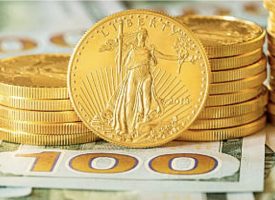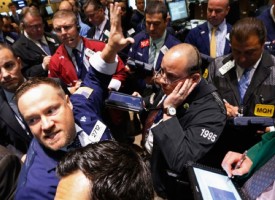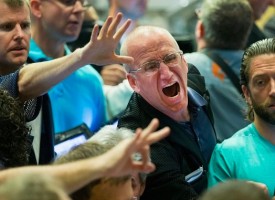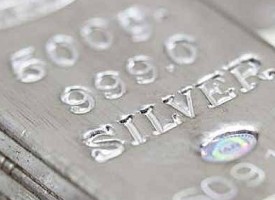As we come to the end of what has been a wild week of trading, here is where things stand.
June 30 (King World News) – Here is what Peter Boockvar noted as the world awaits the next round of monetary madness: Succinct Summation of the Week’s Events:
Positives
1) For the sake of the long term health of the global economy and a path away from the lunacy that has become modern monetary policy, Mario Draghi, Mark Carney and Stephen Poloz test the market with communication that they might join the Federal Reserve in beginning to remove extreme accommodation.
2) Headline PCE in May fell .1% m/o/m as expected while the y/o/y gain moderated to a rise of 1.4% (slowest since November) from 1.7% in April as the energy influence wanes. Core inflation is moderating as well with a .1% m/o/m rise for a 2nd month. The y/o/y gain of 1.4% was as forecasted vs 1.5% in April and the lowest print since December. There still is the differential between falling goods prices (down .2% led by a 2.5% y/o/y drop in goods) and rising services inflation (up 2.2% y/o/y but seeing a slowing pace of gains).
3) Wholesale inventories in May were up by .3% m/o/m, one tenth more than expected and April was revised up one tenth. Inventories were a major drag on Q1 GDP.
4) The June Conference Board Consumer Confidence index rose 1.3 pts to 118.9 and that was better than the expected drop to 116. It is up from 117.6 in May but a touch below the 119.4 print in April. The two main components however were mixed as Present Situation was higher by almost 6 pts while Expectations fell by 1.7 pts. Those that said jobs were Plentiful rose 2.8 pts to the best level since August 2001 and we see the same thing in the Job Openings data. Those that said jobs were Hard to Get fell by .3 pts to the lowest level since February 2007. Those expecting an increase in Income rose 3.1 pts to a 3 month high but there was also an increase in those expecting a decrease to a 5 month high. The answers to the household spending decision questions remain very mixed notwithstanding the headline confidence number jump since the election. Those that plan on buying a vehicle within 6 months fell .3 pts to the lowest level since July 2016 as we know what is now going on in the auto sector. Those that plan to buy a home fell .2 pts to the weakest level in 5 months. Those that plan to purchase a major appliance rose 2 pts after falling by 4.4 pts last month. Lastly, those that plan on taking a vacation within 6 months fell to the least since last June. One year inflation expectations fell one tenth to 4.6% which is the 2nd lowest print since 2007. The Conference Board gave this bottom line, “Overall, consumers anticipate the economy will continue expanding in the months ahead, but they do not foresee the pace of growth accelerating.”
5) The home price gains are still pretty consistent in the 5-6% range but for the first time in 7 months in April (yes dated data), home price gains moderated y/o/y to a 5.67% pace and the m/o/m rise was the slowest since August. The price rises of course have been great for homeowners but becoming more frustrating for buyers. Sorry if you’re looking to buy in Seattle as prices there are up 13% y/o/y. If you want to live near the Rock n Roll Hall of Fame, you’re in luck as prices in Cleveland grew at the slowest pace of the 20 cities with a 3.4% gain. DC, NY and Chicago followed with the weakest price gains.
6) Both the Richmond and Chicago manufacturing PMI’s for June surprised to the upside and jumped m/o/m. Notable in the Chicago release, Employment did moderate by a .5 pt as “Panelists were concerned about finding reliable, well qualified workers and there was a rise in temporary hires, a growing job market trend in recent months.” Maybe this is a possible reason why wage gains are muted while the labor market is tight.
7) The exports of goods in May rose to a 3 month high, up by .4% m/o/m. Imports though fell by .4%.
8) Consumer spending was up .1% m/o/m after a .4% rise in April as expected. The internals were mixed as spending on goods declined (down 3 of the last 4 months) but was offset by a rise in spending on services which is getting more and more dominated by healthcare. Combined with the income data discussed below led to a 4 tenths increase in the savings rate to 5.5%, the most since September.
9) It’s very old news but real Q1 GDP was revised up by two tenths unexpectedly to 1.4%. Nominal GDP however was actually revised down to 3.3% from 3.4% as the price deflator was revised lower by 3 tenths. Personal spending was revised up too but much was related to higher spending on healthcare. Capital spending was revised lower as was spending on structures, both commercial and residential. Trade was revised higher while inventories were even more of a drag which led to an upward revision to real final sales to 2.6% from 2.2%. Corporate profits after tax and adjusted were revised slightly lower to a 4.1% y/o/y rise vs 4.3% in the previous report. Without adjustments they were down by 7.3% y/o/y.
10) The Economic Confidence index in the Euro area in June improved to 111.1 from 109.2 in May and that was 1.6 pts better than expected. It’s at the best level since August 2007. Each of the components on manufacturing, services, consumer, retail and construction were higher m/o/m.
11) CPI in the Eurozone in June rose 1.3% y/o/y, one tenth more than expected but down one tenth from May. The core rate though rose two tenths m/o/m to 1.1% and one tenth above the forecast and this matches the quickest pace of core inflation since mid 2013 if we don’t include the April 1.2% print that was distorted by the timing of Easter. Services inflation in particular was higher by 1.6% y/o/y, matching a 39 month high, again excluding the Easter impact in April which needs to be averaged with March.
12) Business confidence continues to improve in Germany on the heels of the French election as the IFO index for June rose .5 pt to 115.1 which was above the estimate of no change and is at an all time high. Both the Current Assessment and Expectations components were up m/o/m. IFO said simply, “Germany’s economy is performing very strongly.”
13) German retail sales rose .5% m/o/m, two tenths more than expected and the y/o/y gain was pretty solid at 4.8%, the best since April 2016.
14) French consumer spending best expectations in May as the economic mood has clearly changed for the better there. Sales rose 1% m/o/m, twice the estimate. The June consumer confidence index there rose 5 pts m/o/m to match the best level since 2002.
15) The ECB said money supply growth in the eurozone was up by 5% y/o/y as expected in May, similar to trends seen. Household loans were up by 2.6% y/o/y which is a further improvement from the 2.4% level in April. Lending to businesses rose by 2.4% y/o/y, the same pace as April.
16) In the UK, the CBI retail sales index did improve to 12 in June from 2 in May. The estimate was 5. The CBI said, “The start of summer has seen shoppers hit the high street, lifting sales, if only modestly. However, there’s no getting away from the fact that life is getting tougher, with retailers clearly cautious over the near term outlook.”
17) The Japanese labor market still remains drum tight as the Job To Applicant ratio ticked up another tenth to 1.49, the most since 1974. It peaked at 1.08 in the mid 2000’s expansion.
18) Cheerful for the Japanese citizenry but disappointing for the BoJ, the core/core CPI rate in May(ex food and energy) was unchanged m/o/m instead of rising one tenth as expected. The more up to date June read for Tokyo saw prices drop .2% ex food and energy vs the estimate of no change.
19) Overall household spending in Japan in May fell .1% y/o/y and while better than the forecast of down .7%, is still negative for the 20th month in the past 21.
20) China’s state sector weighted PMI manufacturing and services indices for June improved slightly m/o/m. The manufacturing PMI was up by .5 pt to 51.7, above the estimate of 51 and the best since November. New orders and exports in particular improved but employment fell slightly and is still below 50. Backlogs rose but are also still below 50. Prices were up slightly for both inputs and outputs. As for business expectations, they rose to a 4 month high. The services PMI in China in June was up by .4 pt to 54.9 and this does include the property sector. This index is at a 3 month high. New orders improved to 51.4 and backlogs, export orders and employment were up too but are all still below 50. Business expectations rose .9 pt to 61.1, a 3 month high too…
IMPORTANT:
KWN receives so many emails from its global readers and listeners about which high-quality mining companies they should invest in, and as a result we have added another remarkable company to the list. This is one of the greatest gold opportunities in U.S. history and you can take a look at this remarkable company and listen to the just-released fantastic interview with the man who runs it by CLICKING HERE OR BELOW
Negatives
1) No one should be naïve enough to think that a new global monetary regime (tightening instead of easing) that may be upon us will unfold at all smoothly. If history is any guide as it should be to all of us, it will most likely it will lead to a recession and a decline in asset prices. We of course are hoping for different.
2) Initial jobless claims rose 2k w/o/w to 244k, 4k more than expected and brings the 4 week average to 242k from 245k because a print of 255k dropped out. Continuing claims, delayed by a week, rose by 6k and is quietly at a 4 week high.
3) Pending home sales in May fell .8% m/o/m decline instead of rising by 1% as expected. Also, April was revised lower by 3 tenths. This is the 3rd straight month of m/o/m declines and the index is at a 4 month low. The NAR said “buyer interest is solid, but there is just not enough supply to satisfy demand. Prospective buyers are being sidelined by both limited choices and home prices that are climbing too fast.” The NAR did add something more to their concerns and this is more broader: “Weaker financial and economic confidence could also be playing a role in the slowdown in contract activity.” The NAR had a quarterly survey released a few days ago and “found that fewer renters think it’s a good time to buy a home, and respondents overall are less confident about the economy and their financial situation than earlier this year.” As for current homeowners and the high prices they see in the market, the NAR said “A much higher share of homeowners compared to a year ago think now is a good time to sell.”
4) The MBA said mortgage applications to buy a home fell for a 3rd straight week by 4.1% and puts this index at a 4 week low. It does though still remain up by 7.8% y/o/y. Refi’s fell by 8.6% w/o/w after 3 weeks of gains and is down 35% y/o/y.
5) US capital spending remained weak in May. Core spending fell .2% m/o/m instead of rising by .4% as expected. April was revised up by one tenth. Also, shipments fell by .2% m/o/m vs the estimate of up .4%.
6) Personal income in May rose .4% m/o/m, one tenth more than expected but April was revised down by one tenth so a push. The y/o/y gain was 3% which is the slowest since December. Digging within saw private sector wage/salary growth up 2.9% y/o/y, a 4 month low.
7) Retail inventories in May were higher by .6% and almost solely in where the trouble is brewing, auto’s. Motor vehicles/parts inventories jumped 1.1% m/o/m and are higher by 7.5% y/o/y. To put into perspective, total retail inventories were higher by 3.2% y/o/y and ex the auto sector were up just .9% y/o/y.
8) JD Power and LMC Automotive trimmed its 2017 estimate again for new vehicle sales to 17.1mm from 17.2 previously. This is the 3rd straight month they’ve cut their forecast. An analyst at JD Power said “The auto industry is pacing towards its weakest first half since 2014. While the retail selling rate has declined in four of the first six months, the broader concern remains the negative health indicators behind the sales results.” Also, total incentive spending is up 11.7% y/o/y year to date. With respect to inventories, “days to turn…remained at 70 through June 18. This is the highest level since July 2009 (80 days). GM also cut its full year estimate also to the 17mm range for the industry.
9) The June Dallas manufacturing index fell 2.2 pts to 15. The estimate was 16. New orders are just off the lowest level since November.
10) The final June UoM consumer confidence index was 95.1, better than the 1st print of 94.5 but still down 2 pts m/o/m and is at the lowest level since November. Similar to the Conference Board measure, the components were mixed as Current Conditions were up from May but the Expectations component fell to 83.9, the lowest since October when it touched 76.8 and vs 82.7 in September due to a decline in Business Expectations. Those expecting Higher Income was unchanged m/o/m but fortunately there were less people expecting Lower Income. Employment expectations fell 2 pts m/o/m. The category called “Country will have continuous good times over next 12 months” fell to the lowest since November, down 9 pts m/o/m. The answers to the labor market questions remain mixed. One year inflation expectations held at 2.6%. The UoM did say this, “The combination of continuing improvements in personal finances and increasing concerns about the economic outlook is typical around cyclical peaks. Nonetheless, the data provide no indication of an imminent downturn nor do the data provide any indication of a resurgent boom in spending.”
11) German unemployment unexpectedly rose by 7k in June vs the estimate of a drop of 10k but the unemployment rate held steady at 5.7% (not harmonized with how rest of Europe calculates it which would have it with a 3 handle).
12) The Japanese unemployment rate in May jumped 3 tenths to 3.1% in part due to a 30k person drop in employment and a 220k increase in the size of the labor force. Positively though, the participation rate rose 5 tenths to 60.8%, the most since 2008.
13) Japanese retail sales in May fell 1.6% m/o/m, worse than the estimate of down 1%.
14) Japanese industrial production fell 3.3% m/o/m in May vs the estimate of down 3% but is still up almost 7% y/o/y.
15) Exports out of Hong Kong in May rose 4% y/o/y and that was half the estimate and the slowest pace of gain in 4 months. Imports were higher by 6.6% and that was also below the estimate of up 8.8%. A Hong Kong government spokesman sounded optimistic but with caveats: “Looking ahead, the improving global economic situation should continue to be conducive to Asia’s as well as Hong Kong’s export performance. Yet, the external trading landscape is still overcast by uncertainties arising from the pace of US monetary policy normalization, Brexit as well as other policy and political developments in the US and Europe. Also, the risks of rising protectionist sentiment and geopolitical tensions in various regions persist.”
***To listen to one of the greatest interviews ever with Dr. Paul Craig Roberts, where he discusses the smash in the gold market, global chaos and much more, CLICK HERE OR ON THE IMAGE BELOW.
***ALSO JUST RELEASED: This Is One Of The Most Terrifying Charts Of 2017 CLICK HERE.
© 2017 by King World News®. All Rights Reserved. This material may not be published, broadcast, rewritten, or redistributed. However, linking directly to the articles is permitted and encouraged.








